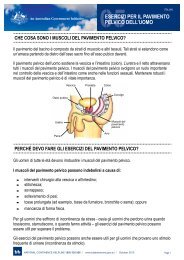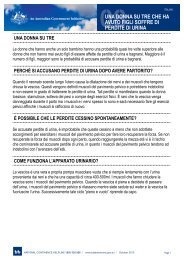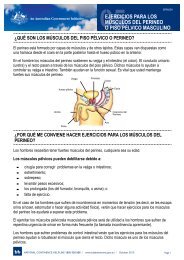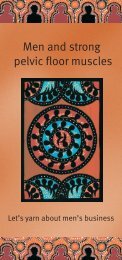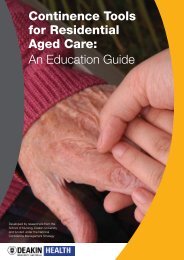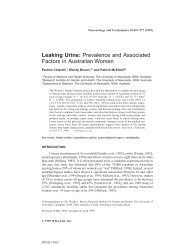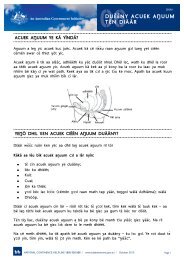Pharmacy Continence Care - Bladder and Bowel Website
Pharmacy Continence Care - Bladder and Bowel Website
Pharmacy Continence Care - Bladder and Bowel Website
You also want an ePaper? Increase the reach of your titles
YUMPU automatically turns print PDFs into web optimized ePapers that Google loves.
3.6 Consumer participation<br />
Consumer participation in the project was a major aim with the objective of assessing the<br />
extent to which pharmacy provided information <strong>and</strong> assistance resulted in consumer benefit,<br />
including positive health behaviour or improved health outcome.<br />
Despite a carefully designed <strong>and</strong> well resourced consumer recruitment strategy, however,<br />
the participating pharmacies recruited less than one tenth of the target number of<br />
consumers for evaluation of the health <strong>and</strong> individual benefits of the Program. Feedback<br />
from a number of the participating pharmacies has suggested that pharmacy staff consider<br />
consumers are hesitant to participate because of their reluctance to publicly self-identify as<br />
having continence issues. Follow-up by the project team indicated that pharmacies do not<br />
have a practice of seeking customer feedback <strong>and</strong> this may also have been a contributory<br />
factor.<br />
To evaluate consumer benefits, pharmacies were asked to encourage <strong>and</strong> support customers<br />
to whom continence information, advice or referral was offered (people with or at risk of<br />
incontinence, <strong>and</strong> carers), to complete a baseline survey questionnaire in the pharmacy at<br />
the time of the intervention. In recognition of the time impost for customers likely to have<br />
limited time or interest in staying to complete a questionnaire after completing their visit to<br />
the pharmacy, incentives to participate were developed <strong>and</strong> identified in consumer<br />
information <strong>and</strong> on the consumer baseline survey questionnaire. Each consumer who<br />
consented to be part of the trial was issued a printed questionnaire, together with a printed<br />
reply-paid envelope addressed to the survey firm, Ipsos Australia, to protect respondent<br />
confidentiality.<br />
The consumer recruitment target established by the project team, after literature review <strong>and</strong><br />
consultation with members of the NOVA Expert Panel, was 500 consumers, an average of 10<br />
consumers to be recruited by each pharmacy to respond to the pharmacy-based, selfadministered<br />
consumer interview schedule. Each pharmacy was asked to enrol up to 10<br />
customers to participate in the baseline <strong>and</strong> follow-up survey by completing the consumer<br />
questionnaire, in the pharmacy, at enrolment, <strong>and</strong> to consent to a follow-up telephone<br />
interview to complete the questionnaire at three months post enrolment. This sample size<br />
was considered to be achievable, based on the number of people with incontinence in the<br />
general population estimated to attend a community pharmacy, <strong>and</strong> the pilot Program trial<br />
period of three months was determined to provide pharmacies with sufficient time to recruit<br />
10 or more participating customers. It was expected that larger pharmacies would potentially<br />
recruit more than 10 participating consumers, <strong>and</strong> that smaller pharmacies would potentially<br />
recruit five or more over the three-month trial period. The project methodology proposed<br />
that the 500 recruited consumers would be asked to consent to a follow-up study, to be<br />
administered to a r<strong>and</strong>omly selected sub-sample of 300 respondents by Computer Aided<br />
Telephone Interview (CATI), by the market research firm Ipsos Australia.<br />
Recruitment of consumer participants in the evaluation of the pilot Program was promoted at<br />
the time of the <strong>Pharmacy</strong> Initial Questionnaire through an interviewer information guide;<br />
through provision of a comprehensive <strong>and</strong> substantial consumer information resource kit to<br />
each pharmacy (see Appendix 1.1.3), <strong>and</strong> through a financial incentive offering participation<br />
in a draw for travel vouchers for pharmacies that succeeded in recruiting 10 or more<br />
consumers, <strong>and</strong> for those who succeeded in recruiting five to nine consumer participants.<br />
Participating consumers were advised in a brief introductory letter, attached to the printed<br />
consumer questionnaire <strong>and</strong> signed by the Project Director, <strong>and</strong> again on the questionnaire,<br />
that their participation would be recognised by inclusion in a draw for a travel voucher.<br />
Despite these strategies, at the conclusion of the pilot Program operational period, at the<br />
end of July, only 24 consumer questionnaires had been returned. In an endeavour to<br />
improve this extremely low recruitment, the project team advised pharmacies, by electronic<br />
Final Report<br />
19<br />
NOVA Public Policy<br />
<strong>Pharmacy</strong> <strong>Continence</strong> <strong>Care</strong> Project



